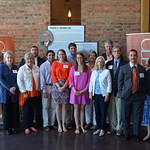Keeping the pipeline filled with diverse talent

Duke Energy is continuing to support two Clemson summer programs — one for middle school girls and one for incoming University freshmen — with an $85,000 grant from the Duke Energy Foundation. Both programs are aimed at increasing diversity in the pipeline that carries talent from the classroom to the workplace.
Project WISE is designed to educate middle school girls about opportunities in science, technology, engineering and math, or STEM, at a time of life when peer pressure tends to drive them away. The PEER and WISE Experience offers 50 incoming freshmen a head start on academics and campus life. Both programs, which are based in the College of Engineering, Computing and Applied Sciences, are designed for students from groups who are underrepresented in STEM fields, including women and minorities.
[pullquote]“We know that quality education programs like these are critical to creating the high-tech, diverse workforce we need for the 21st century,” said Kodwo Ghartey-Tagoe, Duke Energy’s South Carolina state president.[/pullquote] “Partnering with great institutions like Clemson University helps our communities continue to grow and produce skilled workers who bring new ideas and innovations to our lives.”
About 60 middle school girls attended Project WISE this past summer. This year’s program targeted Title I schools in the Pee Dee, a region where Duke Energy is working to have great impact. Girls attended mini-courses in a range of topics from electrical engineering to computer science, taught by Clemson faculty and staff. Ten undergraduate Clemson students lived in residence halls with the Project WISE girls.
Serita Acker, director of PEER and WISE, said that since Project WISE started in 1997, many of the program’s alumni have come to Clemson, majoring in STEM disciplines. “All of the research shows that middle school is when you start thinking about what you want to do,” Acker said. “What makes us unique is we have all these young women in our college who serve as role models. Students can see what they could be like in the future.”
The PEER and WISE Experience, based on two previous summer programs aimed at helping ease students’ transition to college, had its inaugural three-week session in July. While living on campus, students studied college calculus, physics and chemistry and learned about research, graduate school and success strategies, such as time management. They also met alumni, providing them role models to emulate.
Acker said Duke Energy has long been key to the success of PEER and WISE and thanked the company for its latest contribution. “It not only plants the seed of STEM, it plants the seed of what the future can be when you get a college education,” she said. “Together, we are keeping the pipeline filled with diverse talent.”










